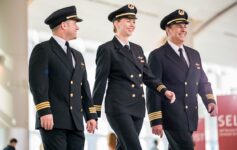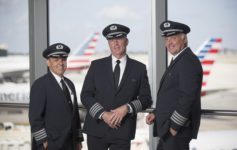
The “1500-hour rule” has been a flashpoint in U.S. aviation ever since Congress imposed it in 2013. Proponents say it makes flying safer. Critics argue it is unnecessary and drives up costs. But what the rule actually requires, and what it really accomplishes, is often misunderstood. 121 pilot, our resident commercial airline pilot on Live And Let’s Fly, brings us a two-part story on “1500-hour rule” for commercial airline pilots. Here’s part one.
The 1500-Hour Rule And What No One Is Talking About
The 1500-hour rule has been the subject of intense debate in recent years with regional airlines struggling to find enough qualified candidates to fill their cockpits. On one hand, you have critics who charge that it’s nothing more than a shameless play by ALPA to restrict the pool of available pilots and therefore drive up wages for its members. On the other side ALPA loves to cite a 99.8% reduction in passenger fatalities in airline operations since the rule was adopted. It, of course, shouldn’t be a surprise that the regional airline industry that had traditionally massively underpaid pilots would advocate for policies that might make that easier. It is, however, absolutely shameful for ALPA to knowingly misrepresent safety data to advance a cause, no matter how noble. Let’s break down some of the myths around the 1500-hour rule and then in part two I will discuss why this pilot thinks it’s a good idea.
What Is The 1500-Hour Rule?
In order to be an airline pilot under the rule, pilots are required to have a minimum of 1500 hours of total flight time. When implemented, this was a significant increase over the 190-250 hours that was previously required. There are three exceptions to this rule. First, Military pilots can qualify with 750 hours, second, those who earn a bachelor’s degree in aviation can reduce the requirement to 1000 hours and third, an associate’s degree in aviation allows a reduction to 1250 hours.
Myth 1: 1500-Hour Rule And Safety Claims
Myth one: the 1500 hour rule has resulted in a 99.8% reduction in fatalities. For this to be true you would need to be able to look at accidents that happened prior to the rule and point to a pilot with less than 1500 hours as a contributing factor. But, none of the accidents that have happened in airline operations in the period ALPA likes to reference had pilots with less than 1500 hours. So, it’s a lie to say that any part of the reduction in fatalities has been driven by the 1500-hour rule. Right now, there are no studies that show the 1500-hour rule has improved aviation safety.
Myth 2: The Rule Caused A Pilot Shortage
Myth two: the 1500-hour rule created a shortage of pilots leading to major wage gains, especially at the regional level. This myth has grains of truth to it, however, it overlooks other factors and history. First, at least in the US, it has been traditionally very rare for an airline, regional or otherwise, to hire a pilot with less than 1500 hours. There have been exceptions of course. For example, at one point, many regional airlines would hire pilots who had completed internships with much lower total experience. But the real driver in the wage gains that happened a few years ago was driven by what was happening at the major airline level. Major airlines came out of COVID having thinned their ranks to find a recovery in travel demand that exceeded even the most optimistic assumptions.
The result combined with a significant wave of retirements, was a very accelerated demand for new hires to fill the seats. Most of this hiring came as a result of pilots at the regional level moving up to a major, and as you might expect existing Captains at regional airlines were in high demand. This created a two-fold problem at the regional level. First, they had to find qualified pilots whom they could hire to fill the vacancies being created. But, more critically, the regionals struggled to fill their Captain seats. The inability to fill the left seat was itself driven by two factors.
First Experience. Because in order to be a Captain you need 1,000 hours of experience in airline flying or equivalent under the rules. So, if your losing Captains at an accelerated rate you might find that you can’t staff your Captain seat because there aren’t enough Captain-qualified pilots available.
Two, regional Captains who were also check airman came to be in even greater demand as these pilots found it even easier to leave for a major. If you don’t have check airman then your training pipeline grinds to a halt, not to mention the requirements for line checks of existing Captains. It was the Captain and especially the check airman drain created by the majors that drove the massive regional pay increases as those airlines fought to hang onto these pilots. Filling the right seat, while a challenge, was a secondary issue.
Myth 3: Pilots Just Fly In Circles
Myth three: the 1500-hour rule results in pilots making endless laps around small local airfields landing and taking off just to build up their time. This isn’t remotely what happens, nor is getting from 250 to 1500 hours the giant obstacle that some people want you to think it is. Because general aviation, in the US, is much cheaper than in Europe; for example, large numbers of prospective European professional pilots come to the US for flight training. This and the accelerated hiring at the airlines mean that it’s not hard to find a position as a flight instructor in the US. Flight instruction is the way a vast majority of pilots in the US get from 250 to 1500 hours. Constantly teaching new pilots basic skills and aeronautical decision-making is actually very valuable experience.
Every day is a new challenge and may mean a student who is making a mistake you haven’t seen before. Being an instructor also means that you’re the pilot in command. You’re the ultimate authority when decisions have to be made regarding the safe conduct of the flight. That practice in aeronautical decision-making leads to better airmanship, the need for which I’ve written about in the past.
When you’re sitting in the right seat of a 737 you’re aware of decisions being made and the better Captains will involve you in them. But that’s not the same thing as sitting in the left seat yourself. Study after study has shown the best way to learn something is to teach it and that’s very true in aviation. I also believe that the hours spent actually flying small general aviation types early in your career lay an enormously valuable foundation in terms of skills. A foundation you don’t get when you move into a modern highly automated jet very early in your career where you spend the majority of your time watching the automation do its thing.
CONCLUSION
The 1500-hour rule did not singlehandedly improve safety, nor did it create the pilot shortage. What it did do was create a baseline standard. Debunking the myths is important so that when we discuss the rule’s merits, we are honest about what it does and doesn’t do. In the next piece, I’ll explain why, despite the myths, the 1500-hour rule remains worth defending.
Read part two here.
> Read More:Airmanship – What Pilots Need Most




Both pilots in the Colgan Air crash were hired with less than 1500 hrs.
Both had over that amount at the time of crash and it’s undisputed that had the rule been in place it would not have made any difference.
Would’ve required additional training and for the FO to hold an ATP. While I agree with your premise, the big success of the 1500 hr rule was raising training standards and rest requirements. Colgan was a shit bag operator with terrible training.
I vaguely recall research regarding total number of hours and pilot-error accident rates. IIRC inexperienced pilots had the highest rate and pilots with MANY hours had a slightly higher rate (than those with moderate hours) theorized to be due to complacency. Can’t recall if it was military or general aviation or commercial aviation and can’t recall cutoffs for moderate and many hours, maybe something like 500-5000 and over 5000.
The Colgan flight was the first flight of a trip for both pilots. Neither pilot reported for duty rested. Both pilots commuted to Newark and neither pilot slept in a bed the night before they reported for duty.
Why are there not rules about rest before starting duty? That might make a bigger difference
There are rules about rest and pilots are required to be fit for duty when reporting for work. That being said you can’t regulate everything. The Colgan crash had a lot of drivers and their rest before duty was but a single strand.
But when the Colgan Air crash occurred they were both over 1500 hours. The Captain had more than double that.
The 1500 hour rule is the result of Congress saying “We must do something!!!” under pressure from the relatives of the crash victims.
Primary reason European students come to the US or places like Australia is because the airspace is much more open and the weather is better. They can complete their training in less overall time.
While lots of aspiring airline pilots instruct to build time, this is an economic measure as much as anything. Get someone else to pay for the plane while you build time. You can fly circles for hours if you have the resources to do so. (But being an instructor looks better on the resume.)
In Europe and some other countries you can get an MPL license with less than 300 hours total time. MPL has been around for about 20 years. This allows one to fly F/O on an airline aircraft (usually 737 or A320). The US does not have an equivalent to the MPL.
As part 2 will illustrate I’m not a fan of the European MPL model at all and think it significantly diminishes safety. A pilot with 250 hours is still a total newby and paying passengers deserve more.
Yet we don’t see commercial planes falling from the sky in Europe. Seems to be working just fine unless you show me numbers that dispute this.
The reality is that mental health with pilots should be far more an issue on a global scale. It has become the leading cause of significant fatal accidents in the past few decades that did not involve a 737MAX. That is something to care about. I would rather have a 22 year old with 800 hours who is mentally fit at the controls over a 45 year old seasoned pro with thousands of hours but who is hiding a deep depression.
Always funny to think how a junior widebody FO could go months without a real landing if they only get relief pilot trips. My medium term interest is more the airmanship those who got to widebodys younger and will have a lot less takeoff/landings (but more hours) than previous generations who paid their dues on short-haul routes.
Having learned flight and duty time limitations with CAP 371, some of the 117’s made total sense and made things much easier…specifically Tables A and B and the hard minimum of 10 hours rest.
The problem is that it never addressed fatigue from commuting and neither side had any motivation to change things.
ALPA was happy to let their pilots commute from Florida or Washington State and the airlines were happy as long as the pilots showed up for work.
The fact that cargo carriers still fly under 121 makes you realize it was all a dog and pony show.
I agree with your assessment and support your position regarding the 1,500 hr. requirement. However, I believe there are other factors that ought to be considered and tempered as it relates to this requirement.
First – Experience
To truly be experienced as 1,500 hr. pilot, a person should have advanced flying more complex acft, operated and flown in an instrument environment, in weather conditions that are challenging, in high tempo operating areas, etc. and generally have gained experience and knowledge through a combination of these factors.
Clearly, there is a significant difference in a flight instructor training students and gaining experience in a light single-engine acft in VMC conditions, in contrast to someone who gained experience as I described above.
As a retired Naval Aviator with an ATP and over 10,000 flt. hrs., I can assure you I gained a great deal of experience as a young pilot flying world-wide in the P-3C acft. In fact, I gained a lot of truly great experience flying out of Adak, AK in the most harsh weather conditions imaginable. Also, I instructed at all three (3) levels in Naval Aviation – trainng command, squadron and Fleet Replacement Squadron (FRS)
So, high quality experience is a factor that should be considered in it’s totality.
Second – Training
In combination with high quality experience, is high quality training. The comprehensiveness and quality of flight training can not be overlooked as it forms the bedrock for gaining high quality experience. I can assure you I know this first hand.
As a student Naval Aviator, by the time I earned my wings with just under 300 hours, I had been taught flying skills, headwork and judgment, techniques, practices, etc. through a demanding, rigorous and thorough training program. This training program is second to none.
Conclusion
So, 1,500 hrs. of high quality experience and training, should be strongly considered in assessing a pilot’s knowledge, skills and abilities.
In my view, I see the formula as this:
High quality experience + high quality training = a pilot with the following
– solid flying skills & basic airwork (BAW)
– sound judgment & headwork
– superb flying and operating techniques
– keen practices & procedures
– vast knowledge
As a pilot who owns a Piper PA-28 180 acft and has flown for almost 50 years, I believe my training and experience has served me extremely well.
Without question, we need solid, high quality pilots flying Part 121 and 135 operations. It is my hope that the factors I outlined above will be considered when assessing an applicants skills and abilities.